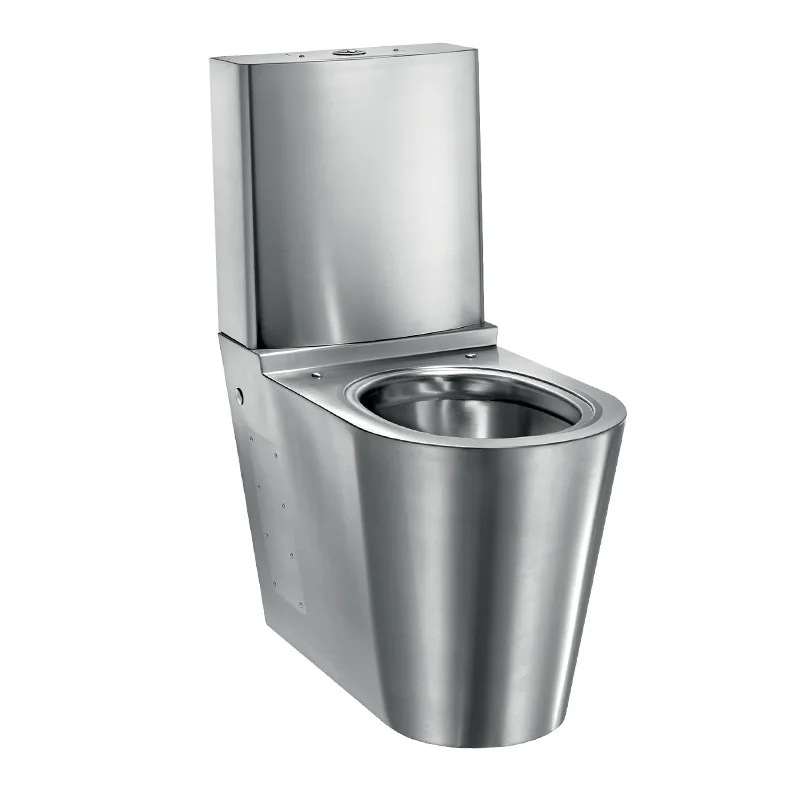Products
The field is required.
ABOUT
Dongguan Haizhilan Intelligent Technology Co., Ltd. is a factory specializing in the production of smart toilets, stainless steel toilets, ceramic toilets and other bathroom accessories. It has a modern office environment and first-class production facilities. It has served more than 50 companies across the country for 12 years and has received unanimous praise. In order to better serve foreign customers, the Foreign Trade Department was established in 2024, and Haizhilan Intelligent Technology will undertake foreign trade business. We always adhere to the core values of "innovation, integrity, professionalism, and excellence" and are committed to providing customers with high-quality products and services.
The Evolution Of Stainless Steel Bathrooms From Industrial Roots To Modern Luxury A Journey Through Time And Design Trends
2025-04-25
Stainless steel restrooms have made amazing progress from being something only functional to place in industrial facilities to being something of a luxurious sanctuary within your home. This evolution is in line with general design movements, technological advancements and shifting consumer preferences. Once appreciated purely for its endurance and cleanliness, stainless steel today is recognized for its high-style look and performance. This article takes a dive into the interesting history of stainless steel bathrooms by drawing the lines from their start to the landmark achievements that affected their evolution, or the design changes that made them the iconic presence they are today when it comes to modern luxury.
How We Ended Up With Stainless Steel Bathrooms
The tale of stainless steel bathrooms starts in the early 20th century with the material’s original use, in industrial settings. Due to its resistance to corrosion, ease of sterilization, and longevity, it was a popular choice for hospitals, factories, and laboratories. Functionality was paramount in these spaces, and the invented of stainless steel addressed the demand for sterile, easy-to-clean surfaces. Early stainless steel bathrooms were uniform in their functional aspect, no nonsense, no frills.
After that, as stainless steel became more affordable, it’s also moved into public restrooms and commercial buildings. The material’s durability made it popular among architects and designers designing high-traffic facilities and in need of coping with heavy use and harsh cleaning agents. It was a time where if you heard about a stainless steel bathroom you thought of cutting edge technology that is hygenic but there were not anything someone would later refer to as a sexy design.
From Industrial to Home Spaces
The middle of the 20th century represented a distinctive point for stainless-steel bathrooms, when designers first started playing around with the idea of using the material in homes. This was in part a result of the modernist movement, which saw in industrial materials clean lines and a minimalist aesthetic. Architects like Le Corbusier and Ludwig Mies van der Rohe championed the use of stainless steel in homes, preventing a clear division from developing between how designs for industry should appear and how residences should look.
It wasn’t difficult to convince homeowners to have stainless steel bathrooms because they thought stainless steal was cold and institutional. Nevertheless, with more sophisticated finishing, reflective, sleeker surfaces were able to undermine the aggressive character of the material. Designers also started mixing stainless steel with warmer materials by then, like wood and stone which offered a more balanced design and appealed to more demographic. By the 1970s, stainless steel bathrooms began to establish a beachhead in high-end housing and thus marked the start of their voyage to luxury.
Contemporary Luxury and Design Innovation
Modern stainless steel bathrooms Steel bathrooms are thought of as a luxury and avant-garde in design terms these days and in fact, the use of stainless steel in residential interiors has never been as stylish. Some even have the option to choose the finish of your stainless steel faucet, be it polished, brushed, or even matte. Not only do these finishes look good, they offer a number of practical benefits, too, such as a resistance to fingerprints and easy cleanability.
Marketing Smart Technology and Stainless-Steel A notable development in bathrooms in recent years has been the introduction of smart technology to stainless steel bathrooms. Incorporating features such as touchless faucets, temperature-regulated surfaces and LED lighting, the user experience is about as scientifically advanced and functional as it comes. Sustainable options have also made there way in to the production of stainless steel; recycled materials and energy efficient manufacturing are now the norm. These developments have further established stainless steel as a luxury, high-end option for modern bathrooms.
What’s Next for Stainless Steel Bathrooms
As design fashions change stainless steel washroom products are likely to play a leading role in luxury and technology. New trends include mixed metals, where steel is used with brass, copper or blackened steel for a lighter but multilayered look. Designers are also toying with textured finishes and unusual forms, playing with the limits of what stainless steel can do.
In addition, increased focus on sustainability will continue to push development in bathroom design with stainless steel. With water saving fixtures and environmentally friendly production techniques, the look of the stainless steel bathroom to the future is one of both luxury and ecological regard. In a world where consumers are looking for spaces that are as strong and beautiful as they are sustainable, stainless steal has longevity with its flexibility and durability.
How We Ended Up With Stainless Steel Bathrooms
The tale of stainless steel bathrooms starts in the early 20th century with the material’s original use, in industrial settings. Due to its resistance to corrosion, ease of sterilization, and longevity, it was a popular choice for hospitals, factories, and laboratories. Functionality was paramount in these spaces, and the invented of stainless steel addressed the demand for sterile, easy-to-clean surfaces. Early stainless steel bathrooms were uniform in their functional aspect, no nonsense, no frills.
After that, as stainless steel became more affordable, it’s also moved into public restrooms and commercial buildings. The material’s durability made it popular among architects and designers designing high-traffic facilities and in need of coping with heavy use and harsh cleaning agents. It was a time where if you heard about a stainless steel bathroom you thought of cutting edge technology that is hygenic but there were not anything someone would later refer to as a sexy design.
From Industrial to Home Spaces
The middle of the 20th century represented a distinctive point for stainless-steel bathrooms, when designers first started playing around with the idea of using the material in homes. This was in part a result of the modernist movement, which saw in industrial materials clean lines and a minimalist aesthetic. Architects like Le Corbusier and Ludwig Mies van der Rohe championed the use of stainless steel in homes, preventing a clear division from developing between how designs for industry should appear and how residences should look.
It wasn’t difficult to convince homeowners to have stainless steel bathrooms because they thought stainless steal was cold and institutional. Nevertheless, with more sophisticated finishing, reflective, sleeker surfaces were able to undermine the aggressive character of the material. Designers also started mixing stainless steel with warmer materials by then, like wood and stone which offered a more balanced design and appealed to more demographic. By the 1970s, stainless steel bathrooms began to establish a beachhead in high-end housing and thus marked the start of their voyage to luxury.
Contemporary Luxury and Design Innovation
Modern stainless steel bathrooms Steel bathrooms are thought of as a luxury and avant-garde in design terms these days and in fact, the use of stainless steel in residential interiors has never been as stylish. Some even have the option to choose the finish of your stainless steel faucet, be it polished, brushed, or even matte. Not only do these finishes look good, they offer a number of practical benefits, too, such as a resistance to fingerprints and easy cleanability.
Marketing Smart Technology and Stainless-Steel A notable development in bathrooms in recent years has been the introduction of smart technology to stainless steel bathrooms. Incorporating features such as touchless faucets, temperature-regulated surfaces and LED lighting, the user experience is about as scientifically advanced and functional as it comes. Sustainable options have also made there way in to the production of stainless steel; recycled materials and energy efficient manufacturing are now the norm. These developments have further established stainless steel as a luxury, high-end option for modern bathrooms.
What’s Next for Stainless Steel Bathrooms
As design fashions change stainless steel washroom products are likely to play a leading role in luxury and technology. New trends include mixed metals, where steel is used with brass, copper or blackened steel for a lighter but multilayered look. Designers are also toying with textured finishes and unusual forms, playing with the limits of what stainless steel can do.
In addition, increased focus on sustainability will continue to push development in bathroom design with stainless steel. With water saving fixtures and environmentally friendly production techniques, the look of the stainless steel bathroom to the future is one of both luxury and ecological regard. In a world where consumers are looking for spaces that are as strong and beautiful as they are sustainable, stainless steal has longevity with its flexibility and durability.
SUBSCRIBE
INQUIRY


